See a lava flow on the Big Island
Seeing flowing lava up close is truly a breathtaking and unforgettable experience. Imagine standing by while the earth churns and molten hot lava oozes across the ground or into the ocean. The Big Island of Hawaii is home to active volcanoes and seeing those volcanoes (and sometimes even a surface flow!) is possible when visiting Hawaii Volcanoes National Park or other areas like Kalapana.
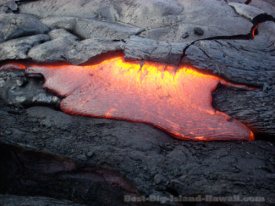 When planning your visit and thinking about whether you'll get to experience a surface lava viewing, it's important to remember that nature can be very unpredictable. The Big Island's volcanoes are an active geological wonder and are always churning below the surface but surface flows are not always occurring or accessible.
When planning your visit and thinking about whether you'll get to experience a surface lava viewing, it's important to remember that nature can be very unpredictable. The Big Island's volcanoes are an active geological wonder and are always churning below the surface but surface flows are not always occurring or accessible.
My best advice is to take the opportunity to see surface lava if you can, but don't be too disappointed if it isn't possible during your visit. The following information will help you find out about whether you might get to see surface lava on the Big Island during your visit, where to go and how to prepare so that, if there is lava that can be viewed, you'll be able to get the most out of the experience and enjoy it safely.
What will I get to see?
The kind of volcanic activity that you've seen on TV—massive eruptions and giant rivers of lava—are not the kind of thing that most people get to see. It's extremely dangerous for anyone to be anywhere near that kind of volcanic activity. So, unless you have a multimillion dollar budget, a helicopter, and a zoom lens that takes two people to carry, you probably won't get to see a National Geographic special unfolding before your eyes. The good news for the rest of us is that this is not what most lava flows in Hawaii are all about. When there is viewable surface lava, it can be very accessible to visitors and the Hawaii Volcanoes National Park Rangers do everything they can to help visitors safely enjoy the breathtaking site of molten lava breaking through the Earth's surface and flowing down into the ocean.
It takes a bit of luck to get this opportunity as weeks and months can go by without any viewable surface lava. But being prepared and knowing where to look will put you in a position to take advantage of the opportunity to view a real lava flow in Hawaii.
Where to Go
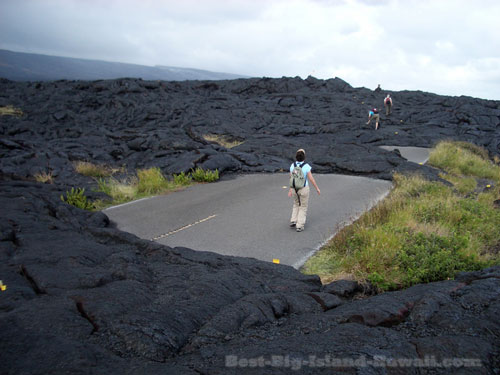 Viewable surface lava flows are accessible through the Hawaii Volcanoes National Park on the Big Island (for general information on visiting the park, check out our dedicated Hawaii Volcanoes National Park Page). If it's a surface flow that you're looking for, the first step is to keep an eye on the daily online updates posted here or here. These sites will let you know if surface lava will be viewable in the area at the end of the Chain of Craters Road or other accessible areas in the National Park. If surface lava is accessible to visitors, Park Rangers at the Visitor's Center will be able to guide you on the specifics for getting there safely on that particular day.
Viewable surface lava flows are accessible through the Hawaii Volcanoes National Park on the Big Island (for general information on visiting the park, check out our dedicated Hawaii Volcanoes National Park Page). If it's a surface flow that you're looking for, the first step is to keep an eye on the daily online updates posted here or here. These sites will let you know if surface lava will be viewable in the area at the end of the Chain of Craters Road or other accessible areas in the National Park. If surface lava is accessible to visitors, Park Rangers at the Visitor's Center will be able to guide you on the specifics for getting there safely on that particular day.
In general, the most accessible surface lava flows in the park are those that appear near the end of the Chain of Craters Road, where a 1986 lava flow crossed the road and provides a site that you certainly don't see everyday.
For additional lava viewing opportunities, consider checking out the Kalapana lava viewing area outside of the park where lava has also been flowing into the ocean for the past several years. Lava viewing opportunities at Kalapana also depend on current conditions. The site is outside of the national park and is administered by Hawaii County authorities, who have their own rules for viewing lava flows.
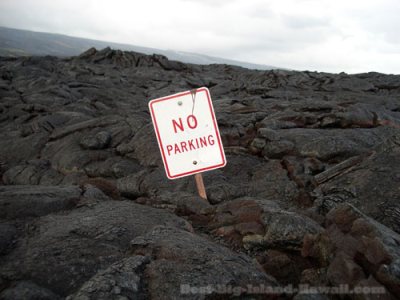
Why did the lava flow cross the road?
To get to the ocean on the other side, of course.
If there is viewable surface lava, you'll want to plan your day around this activity. Get to the end of the Chain of Craters Road with plenty of daylight hours left—hiking across sharp jagged lava rocks is not something you want to rush.
Viewing Surface Lava Safely
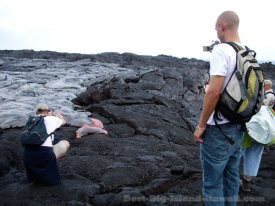 Hiking to see a surface lava flow is quite safe if you are prepared, follow the directions of the Park Rangers, and take the proper precautions. Viewing surface lava flows is not the same as a day at the beach, so you need to dress appropriately. Wear solid closed-toe shoes like hiking boots or sneakers—no flip flops! It can be incredibly hot even at a safe distance from exposed lava but wearing long pants is best to protect yourself from the sharp rocks all around you. Wearing work gloves while you're walking will also give your hands extra protection in case of a stumble. Be sure to stay within marked safe areas and away from the shelf of rock nearest the ocean. While this area may appear stable, it is not and can break away and fall into the sea at any time.
Hiking to see a surface lava flow is quite safe if you are prepared, follow the directions of the Park Rangers, and take the proper precautions. Viewing surface lava flows is not the same as a day at the beach, so you need to dress appropriately. Wear solid closed-toe shoes like hiking boots or sneakers—no flip flops! It can be incredibly hot even at a safe distance from exposed lava but wearing long pants is best to protect yourself from the sharp rocks all around you. Wearing work gloves while you're walking will also give your hands extra protection in case of a stumble. Be sure to stay within marked safe areas and away from the shelf of rock nearest the ocean. While this area may appear stable, it is not and can break away and fall into the sea at any time.
In addition to wearing the proper attire, be sure to bring plenty of drinking water (1-2 quarts per person) and a good flashlight. Hiking out over the rocks in daylight will give you a nice view of the lava with the background of the mountains, the large lava field, and the ocean but the real show begins after dark. You'll want to plan on staying until dark to have the chance to see the surface lava light up in brilliant yellows, reds, and oranges.
Once it gets dark, definitely take your time to appreciate what's going on around you. Let yourself be quiet and enjoy the feeling of seeing the Earth churning around you. Listen to the subtle sounds of rock cracking and lava making its way towards the sea. Walk around and explore but also take the time to sit quietly in a spot where you can see the lava flowing off the end of the Earth and into the sea, creating new land with brilliant colors glowing though a cloud of steam.
Hiking back the way you came becomes much more difficult at night. There are a series of beacons that mark the way but the biggest challenge is navigating each step over the same sharp lava rocks. Take it slow, stay together, and make sure you have a good flashlight—not a dollar store pocket light.
For up to date information and an extensive overview of lava viewing safety, always consult the National Park's What's Going on With the Volcano? page before visiting.
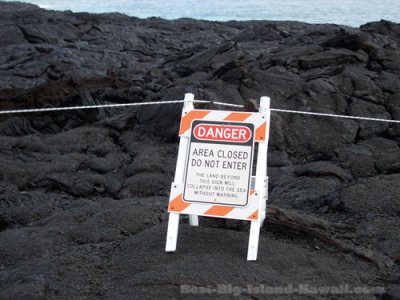
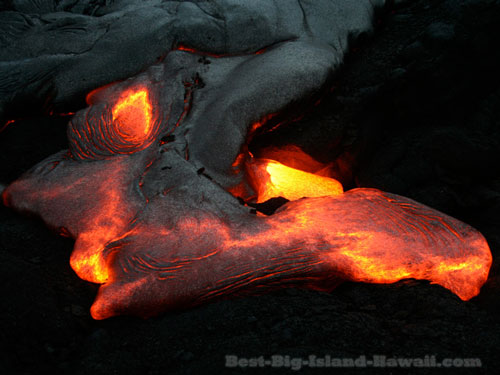
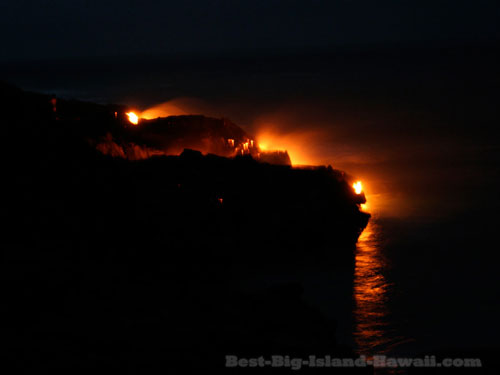
Ready to Go?
Madame Pele, Hawaii's volcano goddess, is unpredictable. While you might get the chance to see an amazing surface lava flow, your visit might also fall during a time when things are relatively quiet in terms of eruption activity. The good news is that the Big Island's volcano sights include much more than just surface lava. Incredible views of the crater, steam vents, diverse vegetation and wildlife, ancient petroglyphs, and ocean views are all available for you to enjoy.
A visit to see an active volcano in Hawaii Volcanoes National Park is an amazing experience whether surface lava is part of the trip or not. Enjoy what's around you and, if you don't get to see everything you hoped for, be sure to make plans to visit again soon.




